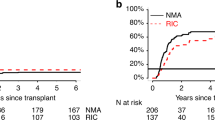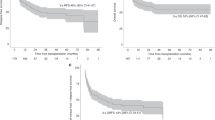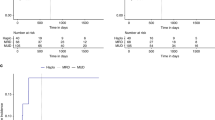Abstract
Therapy-related myeloid neoplasms (t-MNs) are severe long-term consequences of cytotoxic treatments for a primary, often, malignant disorder. So far, the majority of patients eligible for transplantation have undergone myeloablative allo haematopoietic SCT (HSCT) as a potentially curative treatment, but it has been associated with high transplantation-related mortality (TRM) rates. In this retrospective study, we analysed the outcome of patients with t-MNs undergoing HSCT with reduced-intensity conditioning (RIC). Of 55 patients, seen at a single centre over a 10-year period, 17 underwent RIC HSCT with related or unrelated donors. The estimated overall survival was 53% at 1 year and 47% at 3 years, and disease-free survival was 47% at 1 year. At 1 year, the cumulative incidence of relapse and TRM were 24% and 30%, respectively. Of five patients with active primary neoplasms who underwent transplantation, two are alive beyond 1 year and show CR of both t-MNs and the primary malignancy. These data indicate that RIC HSCT is an encouraging approach for patients with t-MNs. The issue of primary malignancies not being in remission at the time of transplantation should be explored in further studies.
This is a preview of subscription content, access via your institution
Access options
Subscribe to this journal
Receive 12 print issues and online access
$259.00 per year
only $21.58 per issue
Buy this article
- Purchase on Springer Link
- Instant access to full article PDF
Prices may be subject to local taxes which are calculated during checkout

Similar content being viewed by others
References
Sill H, Olipitz W, Zebisch A, Schulz E, Wölfler A . Therapy-related myeloid neoplasms: pathobiology and clinical characteristics. Br J Pharmacol 2011; 162: 792–805.
Offman J, Opelz G, Doehler B, Cummins D, Halil O, Banner NR et al. Defective DNA mismatch repair in acute myeloid leukemia/myelodysplastic syndrome after organ transplantation. Blood 2004; 104: 822–828.
Vardiman JW, Thiele J, Arber DA, Brunning RD, Borowitz MJ, Porwit A et al. The 2008 revision of the World Health Organization (WHO) classification of myeloid neoplasms and acute leukemia: rationale and important changes. Blood 2009; 114: 937–951.
Mauritzson N, Albin M, Rylander L, Billström R, Ahlgren T, Mikoczy Z et al. Pooled analysis of clinical and cytogenetic features in treatment-related and de novo adult acute myeloid leukemia and myelodysplastic syndromes based on a consecutive series of 761 patients analyzed 1976–1993 and on 5098 unselected cases reported in the literature 1974–2001. Leukemia 2002; 16: 2366–2378.
Juliusson G, Antunovic P, Derolf A, Lehmann S, Möllgard L, Stockelberg D et al. Age and acute myeloid leukemia: real world data on decision to treat and outcomes from the Swedish Acute Leukemia Registry. Blood 2009; 113: 4179–4187.
Andersen MT, Andersen MK, Christiansen DH, Pedersen-Bjergaard J . NPM1 mutations in therapy-related acute myeloid leukemia with uncharacteristic features. Leukemia 2008; 22: 951–955.
Kern W, Haferlach T, Schnittger S, Hiddemann W, Schoch C . Prognosis in therapy-related acute myeloid leukemia and impact of karyotype. J Clin Oncol 2004; 22: 2510–2511.
Kayser S, Döhner K, Krauter J, Köhne CH, Horst HA, Held G et al. The impact of therapy-related acute myeloid leukemia (AML) on outcome in 2853 adult patients with newly diagnosed AML. Blood 2011; 117: 2137–2145.
Larson RA . Therapy-related myeloid neoplasms. Haematologica 2009; 94: 454–459.
Anderson JE, Gooley TA, Schoch G, Anasetti C, Bensinger WI, Clift RA et al. Stem cell transplantation for secondary acute myeloid leukemia: evaluation of transplantation as initial therapy or following induction chemotherapy. Blood 1997; 89: 2578–2585.
Witherspoon RP, Deeg HJ, Storer B, Anasetti C, Storb R, Appelbaum FR . Hematopoietic stem-cell transplantation for treatment-related leukemia or myelodysplasia. J Clin Oncol 2001; 19: 2134–2141.
Yakoub-Agha I, de La Salmoniere P, Ribaud P, Sutton L, Wattel E, Kuentz M et al. Allogeneic bone marrow transplantation for therapy-related myelodysplastic syndrome and acute myeloid leukemia: a long-term study of 70 patients-report of the French society of bone marrow transplantation. J Clin Oncol 2000; 18: 963–971.
Chang C, Storer BE, Scott BL, Bryant EM, Shulman HM, Flowers ME et al. Hematopoietic cell transplantation in patients with myelodysplastic syndrome or acute myeloid leukemia arising from myelodysplastic syndrome: similar outcomes in patients with de novo disease and disease following prior therapy or antecedent hematologic disorders. Blood 2007; 110: 1379–1387.
Woodard P, Barfield R, Hale G, Horwitz E, Leung W, Ribeiro RC et al. Outcome of hematopoietic stem cell transplantation for pediatric patients with therapy-related acute myeloid leukemia or myelodysplastic syndrome. Pediatr Blood Cancer 2006; 47: 931–935.
Aguilera DG, Vaklavas C, Tsimberidou AM, Wen S, Medeiros LJ, Corey SJ . Pediatric therapy-related myelodysplastic syndrome/acute myeloid leukemia: the MD Anderson Cancer Center experience. J Pediatr Hematol Oncol 2009; 31: 803–811.
Kröger N, Brand R, van Biezen A, Zander A, Dierlamm J, Niederwieser D et al. Risk factors for therapy-related myelodysplastic syndrome and acute myeloid leukemia treated with allogeneic stem cell transplantation. Haematologica 2009; 94: 542–549.
Litzow MR, Tarima S, Perez WS, Bolwell BJ, Cairo MS, Camitta BM et al. Allogeneic transplantation for therapy-related myelodysplastic syndrome and acute myeloid leukemia. Blood 2010; 115: 1850–1857.
Storb R . Reduced-intensity conditioning transplantation in myeloid malignancies. Curr Opin Oncol 2009; 21 (Suppl 1): 3–5.
Nelson Jr RP, Yu M, Schwartz JE, Robertson MJ, Hromas R, Fausel CA et al. Long-term disease-free survival after nonmyeloablative cyclophosphamide/fludarabine conditioning and related/unrelated allotransplantation for acute myeloid leukemia/myelodysplasia. Bone Marrow Transplant 2010; 45: 1300–1308.
Khabori MA, El-Emary M, Xu W, Guyatt G, Galal A, Kuruvilla J et al. Impact of intensity of conditioning therapy in patients aged 40–60 years with AML/myelodysplastic syndrome undergoing allogeneic transplantation. Bone Marrow Transplant 2011; 46: 516–522.
El Kourashy S, Williamson T, Chaudhry MA, Savoie ML, Turner AR et al. Influence of comorbidities on transplant outcomes in patients aged 50 years or more after myeloablative conditioning incorporating fludarabine, BU and ATG. Bone Marrow Transplant 2010; (e-pub ahead of print 8 November 2010; doi: 10.1038/bmt.2010.257).
Kröger N, Bornhäuser M, Ehninger G, Schwerdtfeger R, Biersack H, Sayer HG et al. Allogeneic stem cell transplantation after a fludarabine/busulfan-based reduced-intensity conditioning in patients with myelodysplastic syndrome or secondary acute myeloid leukemia. Ann Hematol 2003; 82: 336–342.
Kröger N, Shimoni A, Zabelina T, Schieder H, Panse J, Ayuk F et al. Reduced-toxicity conditioning with treosulfan, fludarabine and ATG as preparative regimen for allogeneic stem cell transplantation (alloSCT) in elderly patients with secondary acute myeloid leukemia (sAML) or myelodysplastic syndrome (MDS). Bone Marrow Transplant 2006; 37: 339–344.
Valent P, Horny HP, Bennett JM, Fonatsch C, Germing U, Greenberg P et al. Definitions and standards in the diagnosis and treatment of the myelodysplastic syndromes: consensus statements and report from a working conference. Leuk Res 2007; 31: 727–736.
Mickelson DM, Sproat L, Dean R, Sobecks R, Rybicki L, Kalaycio M et al. Comparison of donor chimerism following myeloablative and nonmyeloablative allogeneic hematopoietic SCT. Bone Marrow Transplant 2011; 46: 84–89.
Przepiorka D, Weisdorf D, Martin P, Klingemann HG, Beatty P, Hows J et al. 1994 consensus conference on acute GVHD grading. Bone Marrow Transplant 1995; 15: 825–828.
Filipovich AH, Weisdorf D, Pavletic S, Socie G, Wingard JR, Lee SJ et al. National Institutes of Health consensus development project on criteria for clinical trials in chronic graft-versus-host disease: I. Diagnosis and staging working group report. Biol Blood Marrow Transplant 2005; 11: 945–956.
Kim HT . Cumulative incidence in competing risks data and competing risks regression analysis. Clin Cancer Res 2007; 13: 559–565.
Abdelhameed A, Pond GR, Mitsakakis N, Brandwein J, Chun K, Gupta V et al. Outcome of patients who develop acute leukemia or myelodysplasia as a second malignancy after solid tumors treated surgically or with strategies that include chemotherapy and/or radiation. Cancer 2008; 112: 1513–1521.
Perez-Simon JA, Martino R, Alegre A, Tomas JF, De Leon A, Caballero D et al. Chronic but not acute graft-versus-host disease improves outcome in multiple myeloma patients after non-myeloablative allogeneic transplantation. Br J Haematol 2003; 121: 104–108.
Blade J, Rosinol L, Cibeira MT, Rovira M, Carreras E . Hematopoietic stem cell transplantation for multiple myeloma beyond 2010. Blood 2010; 115: 3655–3663.
Schetelig J, Thiede C, Bornhauser M, Schwerdtfeger R, Kiehl M, Beyer J et al. Evidence of a graft-versus-leukemia effect in chronic lymphocytic leukemia after reduced-intensity conditioning and allogeneic stem-cell transplantation: the Cooperative German Transplant Study Group. J Clin Oncol 2003; 21: 2747–2753.
Dreger P, Brand R, Hansz J, Milligan D, Corradini P, Finke J et al. Treatment-related mortality and graft-versus-leukemia activity after allogeneic stem cell transplantation for chronic lymphocytic leukemia using intensity-reduced conditioning. Leukemia 2003; 17: 841–848.
Peres E, Braun T, Krijanovski O, Khaled Y, Levine JE, Yanik G et al. Reduced intensity versus full myeloablative stem cell transplant for advanced CLL. Bone Marrow Transplant 2009; 44: 579–583.
Ringden O, Karlsson H, Olsson R, Omazic B, Uhlin M . The allogeneic graft-versus-cancer effect. Br J Haematol 2009; 147: 614–633.
Demirer T, Barkholt L, Blaise D, Pedrazzoli P, Aglietta M, Carella AM et al. Transplantation of allogeneic hematopoietic stem cells: an emerging treatment modality for solid tumors. Nat Clin Pract Oncol 2008; 5: 256–267.
Toh HC, Chia WK, Sun L, Thng CH, Soe Y, Phoon YP et al. Graft-vs-tumor effect in patients with advanced nasopharyngeal cancer treated with nonmyeloablative allogeneic PBSC transplantation. Bone Marrow Transplant 2011; 46: 573–579.
Acknowledgements
We thank Ms Eugenia Lamont for editing the manuscript. This work was supported by a grant from the Jubiläumsfonds, Austrian National Bank (Nr. 13918) and Leukämiehilfe Steiermark.
Author information
Authors and Affiliations
Corresponding author
Ethics declarations
Competing interests
The authors declare no conflict of interest.
Rights and permissions
About this article
Cite this article
Zinke-Cerwenka, W., Valentin, A., Posch, U. et al. Reduced-intensity allografting in patients with therapy-related myeloid neoplasms and active primary malignancies. Bone Marrow Transplant 46, 1540–1544 (2011). https://doi.org/10.1038/bmt.2011.165
Received:
Revised:
Accepted:
Published:
Issue Date:
DOI: https://doi.org/10.1038/bmt.2011.165
Keywords
This article is cited by
-
Secondary Adult Acute Myeloid Leukemia: a Review of Our Evolving Understanding of a Complex Disease Process
Current Treatment Options in Oncology (2015)



